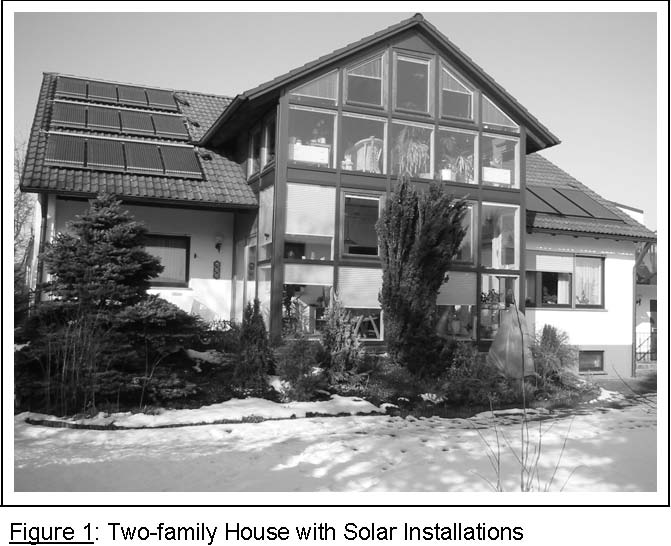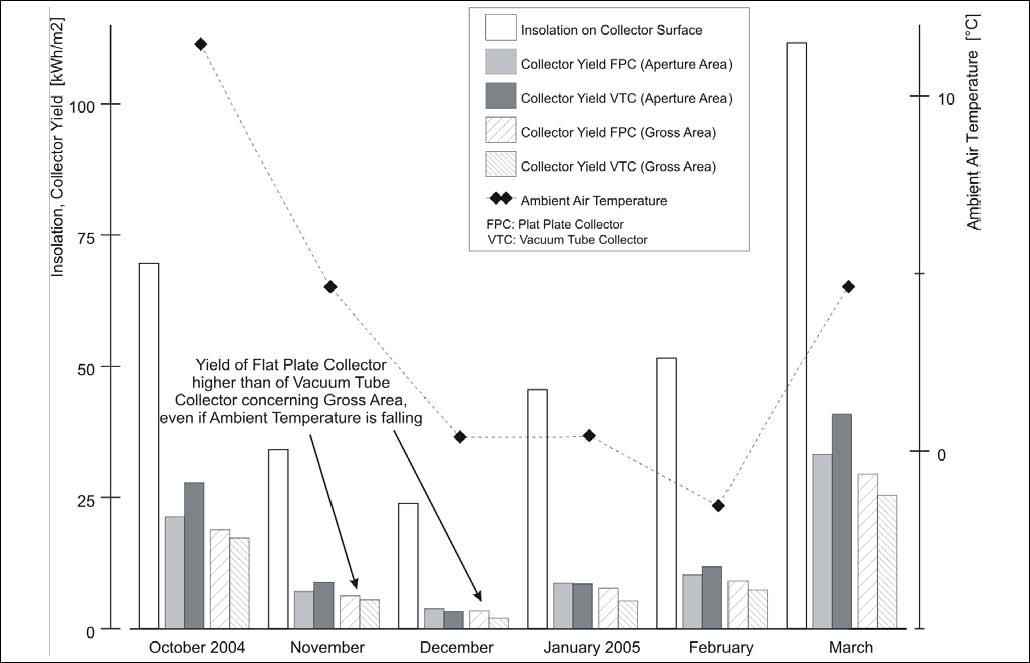Performance of Vacuum Tube and Flat Plate Collectors Concerning Domestic Hot Water Preparation and Room Heating
Christoph Trinkl*, Wilfried Zörner*, Claus Alt**, Christian Stadler**
* CENTRE OF EXCELLENCE FOR SOLAR ENGINEERING at Ingolstadt University of Applied Sciences
Esplanade 10, D-85049 Ingolstadt
Tel.: +49 841 9348-372, Fax: +49 841 9348-99372
E-Mail: trinkl@fh-ingolstadt.de, Internet: www.solartechnik-ingolstadt.de
** Conergy AG, Tuchwalkerstraße 5, D-84034 Landshut, Internet: www.conergy.de
The CENTRE OF EXCELLENCE FOR SOLAR ENGINEERING at Ingolstadt University of Applied Sciences investigates a solar-assisted heating system in a two-family-house. The targets of this project are the demonstration of solar energy utilisation in redeveloped family-houses as well as its potential of CO2 emission reduction. Furthermore, one focus is placed on the evaluation of modern vacuum tube and flat plate collectors regarding hot water preparation and room heating.
The building is a typical two-family house located in the Bavarian countryside (Figure 1). It was originally built in the 1970ies and was modernised in the early 1990ies. A conservatory is integrated in the building. The building structure has relatively high thermal insulation standard. The existing heating system (oil furnace, flat plate collectors, floor heating) was modernised in this project by the integration of modern vacuum tube collectors and a stratification tank (Figure 2). Measurement equipment was installed in the building to monitor the thermodynamic behaviour of the components within the system, especially the energy yield of both the vacuum tube and the flat plate collectors. Apart from that, the storage tank is investigated mainly concerning its stratification behaviour [1, 2].
Figure 3 shows the collector yield of the flat plate and the vacuum tube collectors during the winter of 2004/05. Next to solar insolation in the collector surface, the yield concerning gross area (hatched bars) is shown. During the complete period the flat plate collectors generate higher yield per gross area despite their lower nominal efficiency. The consideration of this collector characteristic area is reasonable when evaluating the two collector types in reality (in addition to laboratory measurements). It is an important product characteristic for consumers because the gross area is required on the roof for heat generation, hence has to be provided and paid by the building owner. Apart from that, the available roof area often is limiting the number of collectors especially in systems for solar heating where larger collector areas are needed.


Figure 2: Hydraulic Scheme and Measurement Equipment
Considering the aperture area (filled bars), the vacuum tube collectors realise a higher yield than the flat plate collectors in autumn and spring. Normally, it would be anticipated that the energy yield of the vacuum tube collectors would rise in comparison to the flat plate collectors when the ambient temperature is falling. But during winter times, the flat plate collectors are at least on one level with the vacuum tube collectors. This is surprising especially when regarding the higher theoretical and nominal efficiency of vacuum collectors.
Figure 4 shows a typical period in January 2005. Insolation is moderate, and ambient temperature is comparably low (<0°C). On 28./29.01. solely the flat plate collectors are working. On 30.01. there are merely perfect conditions for the vacuum tube collectors: High insolation at low ambient temperature. But the vacuum tube collectors are only operating for a short period late in the afternoon when sun is going down. The flat plate collectors in contrast are working the whole day and provide heat on a sufficient temperature level. This indicates, that the vacuum tube collectors are covered with frost or snow in this period and are defrosting very slow due to their very efficient vacuum insulation [3]. Figure 5 shows exemplary photographs of both collectors concerning their behaviour with snow (left) and frost (right). Snow can slide down on the smooth glass surface of the flat plate collectors without difficulty. On the other hand, it gets stuck between the glass tubes of the vacuum collector and the lower collector fastening, even at the slope of 33°.

Figure 3: Insolation, Energy Yield and Ambient Temperature in Autumn, Winter and Spring 2004/05 (data not available for one week in February 2005)

Figure 4: Typical Collector Behaviour in January 2005

Figure 5: Collectors with Snow (left) and Frost (right) during Winter Time Operation
Regarding shadowing of the collectors it has to be stated, that the collector areas face south and the dormer shadows both collector types. The vacuum tube collectors are mounted on the western part of the roof, which is in general the more favourable side concerning defrosting. Furthermore, the vacuum tubes are not shadowed on the top, while the flat plate collectors are mounted on the lower part of the roof.
In general, both collector types are considered to be suitable for solar heating in Central European Climates. The vacuum tube collector, however, does not reach the additional energy yield expected. Thus, the flat plate collector is an interesting alternative for those systems. On the contrary, in winter times, which would be expected to be more favourable for the vacuum tube collector, this collector type offers conceptual weaknesses.
This project is financially supported by the Bavarian State Ministry of the Environment, Public Health and Consumer Protection.
References
[1] S. Müller, C. Trinkl, W. Zörner, C. Alt, C. Stadler: Messtechnischer Vergleich von Vakuumröhren- und Flachkollektoren im Hinblick auf Brauchwasserbereitung und Heizungsunterstützung in einem Zweifamilienhaus, 14. Symposium Thermische Solarenergie, Kloster Banz/Bad Staffelstein (D), 12.-14.05.2004
[2] C. Trinkl, W. Zörner: Vakuumröhren-und Flachkollektoren im Vergleich, Erneuerbare Energien 1/2005, pp. 58-60
[3] C. Trinkl, W. Zörner, C. Alt, C. Stadler: Das praktische Verhalten von Vakuumröhren- und Flachkollektoren im Hinblick auf Brauchwasserbereitung und Heizungsunterstützung, 15. Symposium Thermische Solarenergie, Kloster Banz/Bad Staffelstein (D), 27.-29.04.2005